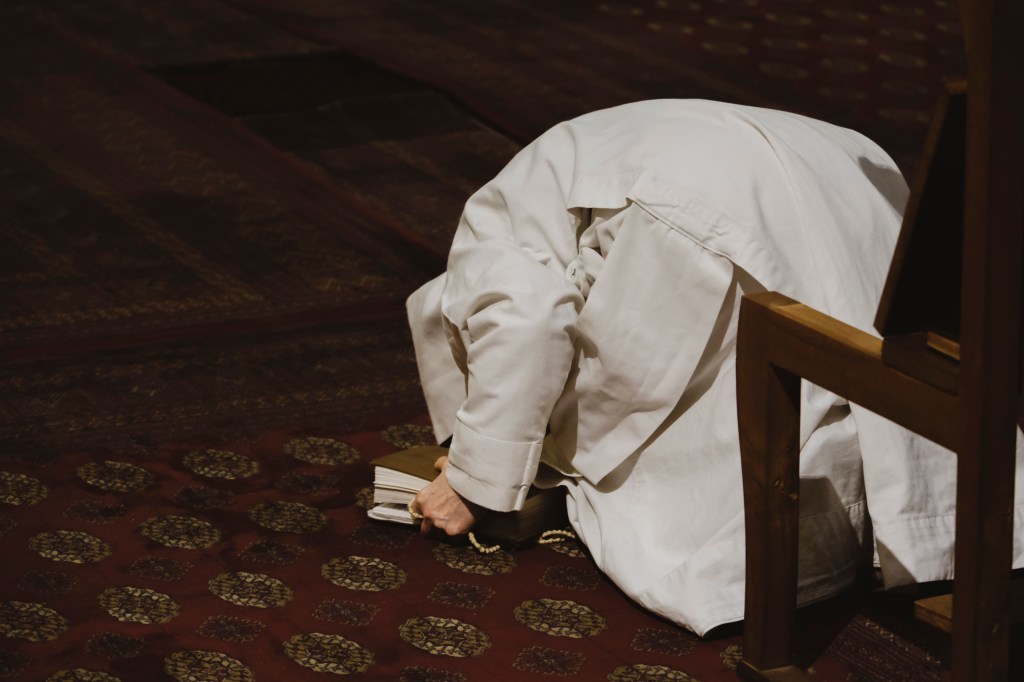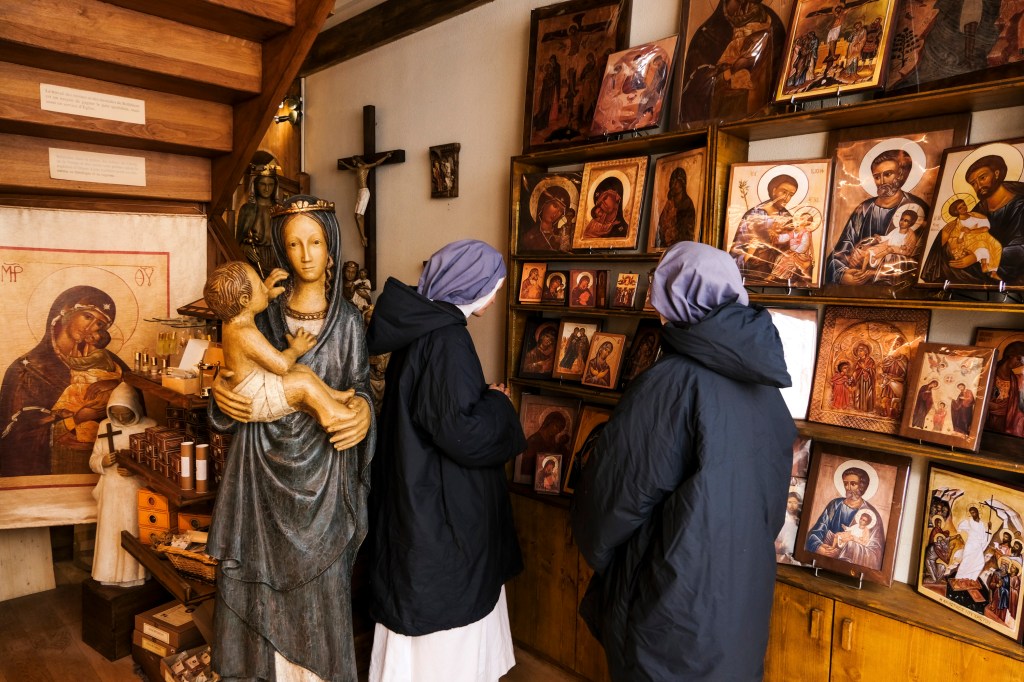It’s 7am, Paris is waking up… At the monastery of Notre-Dame de la Présence de Dieu (“Our Lady of God’s Presence”), hymns have been rising since dawn.
Parisians are probably unaware of this, just as they are unaware of the existence of this monastery nestled in the heart of the capital, in the 16th arrondissement. However, once through the doors of the church, both the curious and regular visitors will have the chance to say a momentary farewell to the incessant din of the city world.

A vocation within a vocation
The Monastic Family of Bethlehem of the Assumption of the Virgin Mary and St. Bruno has thirteen monasteries in France. Most of them are isolated in the countryside, but here in Paris 14 nuns, aged from 36 to 91, live their monastic life. A “vocation within a vocation,” as the Little Sisters of Bethlehem describe it.

For some, it was an obvious choice, like 38-year-old Sr. Félicité, who joined the Bethlehem Family in 2011. “I had just started working in finance at La Défense,” she tells Aleteia. “But I had a very strong desire for a contemplative vocation. When I entered this church, I was immediately drawn to the Blessed Sacrament and felt the call to remain there, at the Lord’s feet.”
Prayer, liturgy, and adoration
Eucharistic adoration is one of the pillars of monastic life in the Bethlehem community. The community was founded shortly after Pius XII proclaimed the dogma of the Assumption in 1950. The new recruits then drew with the Carthusians on the spirituality of the desert fathers, handed down by St. Bruno.
They were sent to the East, in particular to Greek monasteries, from which they brought back the Byzantine liturgy with its hymns and gestures, principally metania (Editor’s note: a gesture consisting of lowering oneself to the ground and rising again in the same movement). “We received the call from the Church to be like a bridge between the monastic tradition of the East and that of the West. To breathe with two lungs, as John Paul II liked to say.”

The nuns of Bethlehem live above all in solitude and silence. They begin their day with a time of prayer in their cell. Of all the services, two are open to the public: matins and vespers, in addition to Sunday Mass. The faithful can come to adore the Blessed Sacrament every day except Monday, when it is exposed every afternoon in a gigantic monstrance. Terce, sext, nones and compline are prayed by each nun separately and simultaneously. Between services, the sisters spend time studying, and then go about their duties: crafts, hospitality, cooking…
The beating heart of the world
“Here in Paris, we are literally at the heart of the world. The horns honking, the shouting, the music, the firemen… are a constant reminder that we are here to offer, to pray, to intercede for all, through the weakness of our own hearts, the vulnerability of our humanity,” continues Sr. Félicité. “When we leave our cells, we look out directly onto the church. Our vocation is marked by places. It’s a constant vigil, like sentinels of the Lord.”
Sr. Église-Marie also discovered her vocation in Paris. A history student, she stumbled into the church on Place Victor Hugo in 2007. “I was seized by the presence of Jesus”, she recalls. Initially a nun in Lourdes, where she stayed for 13 years, she didn’t return to Paris until October 2023. “We experience the same reality in all monasteries. Silence is above all a presence,” she remarks. “You can be surrounded by silence, and have your heart filled with noise… Above all, it’s up to us to create silence.”

No sooner had she uttered these words than the telephone rang in her pocket. Like Sr. Félicité, Sr. Marie-Eglise is in charge of hospitality, which plays a major role in their contemplative life.
Each nun is assigned to a particular task between the various religious services and study times. The sisters make their living by working with their hands: candles, jewelry, wooden statues, earthenware and, of course, iconography. As with the Orthodox, icon art is considered a true form of prayer, which is why the sisters isolate themselves in small studios to paint alone.

Sr. Sabine looks after the sacristy. She arrived in Paris in 1979, eight years after joining the monastery, just as the community was taking up residence at the church. “I came to do the cleaning and help with the moving. It was only supposed to be a weekend, but in the end I stayed,” she laughs.

Along with Sr. Paule, she is one of the oldest members of the Paris community. “Of course it’s different from other monasteries. Conditions are more difficult. But we’re not here for ourselves, we’re here for Christ. We’re learning to live with this particular reality, and that gives another dimension to prayer,” says Sr. Paule.

Time for rest
To enable the sisters to get some fresh air, a number of relaxing times in the schedule. Once a week, the community goes for an early-morning walk in the forest of Versailles. And, not far from Paris, the Poligny (Seine-et-Marne) monastery welcomes those who want to take their “desert day” (Editor’s note: Monday, a day without work or schedules to keep) away from the hustle and bustle of the city. Three weeks a year, the Parisian monastery closes its doors to allow its occupants to go on vacation to one of the monasteries in the countryside.
“These are small arrangements that are specific to our monastery, which allow us to breathe a little,” says Sr. Félicité with a smile. “On Fridays, which is a fasting day, we are allowed little extras like cheese or a banana to help us get through the day,” she continues. “There’s a real wisdom and attentiveness on the part of our leaders, who are attentive to each and every one of us. They know that this is a specific and more tiring situation. There are sisters for whom it’s insurmountable, in which case they leave because they need nature and great calm.”

Peace and quiet were what Sr. Cécile, 91 and the oldest member of the community, was initially looking for. Originally a Salesian, she joined the Bethlehem Monastic Family in 1986, discovering an avid desire for contemplation, and arrived in Paris shortly afterwards. “Oh, it’s the last thing I’d have chosen,” she admits with a laugh. “I hated Paris. But I went. And I’m happy. I live with the essentials, I’ve never doubted.” Sr. Cécile has only one piece of advice for young women wondering about their religious vocation: “Come! You’ll see. I was looking for God, and I found him. You have to try.”
About the Monastic Family of Bethlehem:
As the years went by, new monasteries opened in France and abroad with the agreement of the bishops of the dioceses concerned. The community was established as an institute of pontifical right by a decree on October 6, 1998, approved by John Paul II.
However, several serious accusations of spiritual influence and abuse of authority reached both the Conference of Bishops of France and the Holy See. The denunciation of these internal abuses and dysfunctions, recognized in 2021 by the community, urged the sisters of Bethlehem to request an apostolic visit.
Started in 2015, it was led by Fr. Jean Quris, priest and episcopal delegate for consecrated life in the diocese of Angers, as well as the former mother-abbess of the Benedictine abbey of Jouarre, Sr. Geneviève Barrière. Both toured the monasteries of France for two years, until the end of 2016.
The conclusions of the canonical investigation of the Dicastery for Institutes of Consecrated Life and Societies of Apostolic Life insisted on the need to adapt the internal functioning of the community in order to prevent further abuses of authority.
“The conception of the notion of obedience was not well-adjusted,” Fr. Quris explains to Aleteia. “Which actually led to problems of control in certain monasteries.” The sisters gave priority to collegiality, with the appointment by the Dicastery of Sr. Emmanuel in 2017 as Prioress General of the nuns. She is assisted by a permanent council of six sisters. Fr. Quris and Sr. Geneviève were named apostolic administrators. A listening unit was also set up in January 2021.
Revised starting in 2018, the new monastic Constitutions are still being adjusted and must be presented in Rome during the year 2024. Their first version has been authorized by the Dicastery to serve as a rule of life while awaiting the final version. “There is a real effort on the part of the sisters to implement the requests of Rome, and they are encouraged in their progress by the Dicastery. We believe very much in the beauty of their vocation and in their ability to change the way they govern,” Fr. Quris goes on to note.



